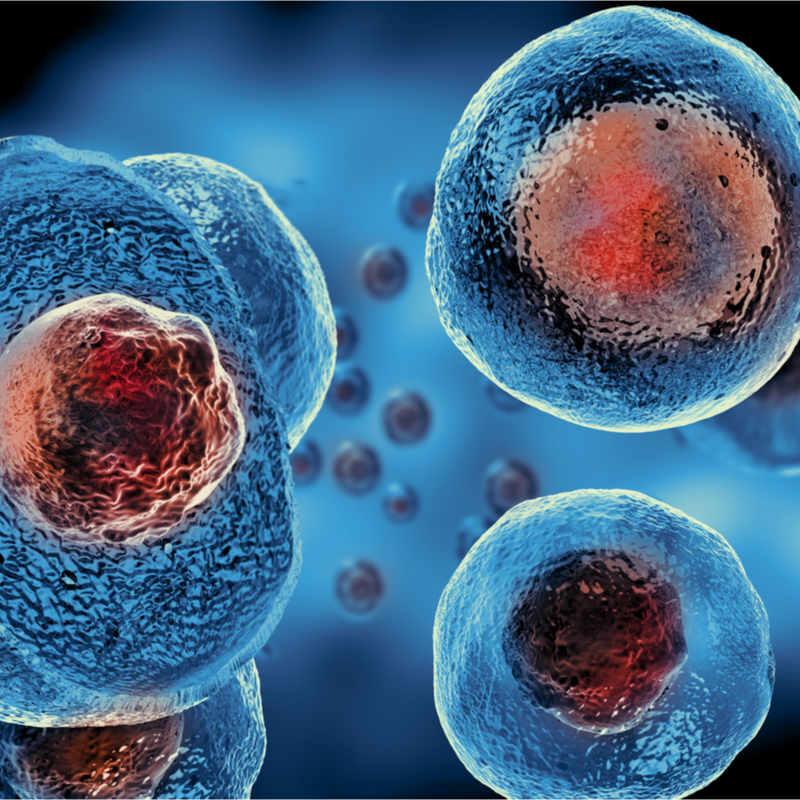
What is a teratoma?
A teratoma is a tumour that develops from the germ cells (pluripotent stem cells). They can be both benign (benign) and malignant (malignant) and are among the most common germ cell tumours, which develop mainly in children and infants. Teratomas can also occur in adults , although men tend to be less affected by the disease than women.
What are the different types of teratomas?
Teratomas are commonly divided into mature and immature teratomas, which can be explained as follows:
- Mature teratomas:
- Occur in an encapsulated form and are filled with a tallow-like material which contains differentiated material. In women, two forms of mature termatoma are distinguished: the dermoid cyst and the struma ovarii. The dermoid cyst describes the most common germ cell tumour and the most common ovarian tumour in childhood. It is usually a benign tumour that rarely tends to degenerate. Struma ovarii , on the other hand, consists mainly of entodermal thyroid tissue. Similar to a dermoid cyst, this type of tumour is usually benign and only rarely tends to metastasise.
- In men mature teratomas usually occur in the form of epidermoid cysts of the testis . Because they consist of pure epidermis, they do not produce hormones.
- Immature teratomas:
- Similar in structure to mature teratomas, but unlike mature teratomas, they carry a risk of degeneration. Immature teratomas occur rather rarely in women and account for only two percent of all ovarian teratomas, which are malignant more often than average. Immature teratomas of the testis in men, on the other hand, are also called teratocarcinomas and are also mostly malignant. There is also a risk of early metastasis .
- Special form of teratoma:
- The so-called fetiform teratoma can be described as a special form of teratoma. This resembles a malformed foetus in which the tissue is very well differentiated.
How does a teratoma develop?
The teratoma consists of pluripotent stem cells and contains tissue of the three germ layers. Doctors assume that the so-called mature teratomas form from the scattered germ cells, which spread throughout the body during embryonic development. However, it is also possible that a teratoma has developed through displacement , for example during an operation or as a result of a trauma. In women, a teratoma can also develop from an egg cell after the first reduction division. This would mean that a teratoma is congenital.
Where do teratomas form more frequently?
In men, a teratoma mainly forms on the testicles, whereas in women the ovaries are more likely to be affected. In rarer cases, the teratoma can also appear in the central nervous system, in the space in the chest cavity (mediastinum) as well as in the soft tissues of the neck, the coccyx and the abdominal tissues.
What are the symptoms of a teratoma?
Teratomas usually do not cause any symptoms and often behave asymptomatically . However, it is not uncommon to notice an increase in circumference in the affected area. This increase in circumference can be manifested, for example, by an increase in the circumference of the abdomen or a bulge in the lower abdomen.
How is a teratoma diagnosed?
In most cases, a teratoma is discovered during a routine ultrasound examination. To be able to diagnose a teratoma with certainty , a tissue sample of the tumour (biopsy) must be taken. If the teratoma contains teeth, a radiological diagnosis using projection radiography or computed tomography (CT) is informative. However, no radiological distinction can be made between a mature and an immature teratoma. This differentiation requires a biopsy of the tumour tissue .
How is a teratoma treated?
The treatment of a teratoma is usually based on whether it is a mature or immature teratoma. In the case of a mature teratoma, an attempt is made, if possible, to remove the entire tumour (resection). As a rule, mature teratomas do not respond to chemotherapy because they do not react to apoptosis (controlled signalling pathway by which cells are to be killed) due to their high p21 level at p53 induction.
Immature teratomas are treated in a similar way to malignant (malignant) ovarian carcinomas or non-seminomas . Accordingly, the affected organ is surgically removed. Depending on the tumour stage, polychemotherapy can also be carried out. In general, it can therefore be stated that surgery is always the first choice of treatment for both mature and immature teratomas. In the case of immature teratomas, chemotherapy is usually also administered after the surgical intervention . Depending on the location of the teratoma , the chances of recovery after chemotherapy are quite good.
What complications can arise from a teratoma?
It is possible for a teratoma to twist, which in turn could result in infarction, perforation and/or bleeding into the abdominal cavity . It is also conceivable that twisting could result in autoamputation of the tumour. The resulting sudden rupture can lead to an acute abdomen (acute abdominal pain). In addition, if the cyst contents empty, this can lead to granulomatous peritonitis (chronic inflammation) .
What is the prognosis for a teratoma?
Since is usually a benign teratoma, especially in children and infants, the prognosis is quite good. In so-called testicular teratomas, which are usually malignant, the prognosis depends on the age of the patient. The chances of cure for ovarian teratomas depend on the degree of differentiation of the tumour. However, as this is also usually a benign cancer , the prognosis is quite good.
